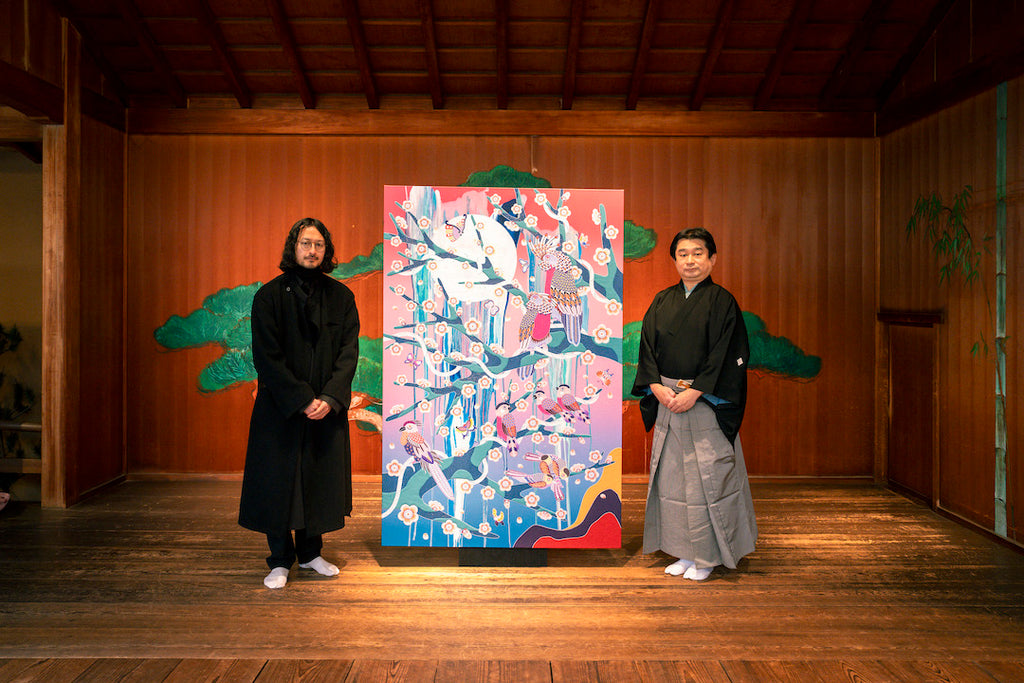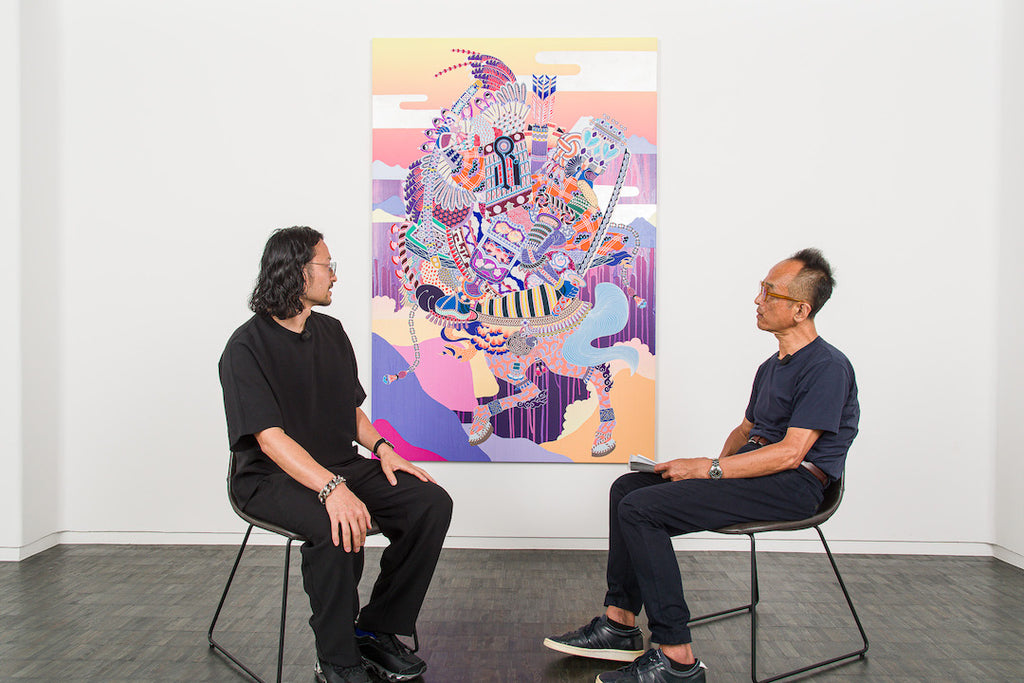ARTICLES
Tracing Roots, Unveiling the Essence of Ornamentation: Kohei Kyomori’s New Perspective
2025.03.31
INTERVIEW

Artist Kohei Kyomori has been creating intricate two-dimensional works characterized by vibrant colors and meticulously crafted patterns, blending decorative elements from various cultures and historical periods. His ongoing exhibition at Whitestone Ginza Gallery and New Gallery, showcases not only his signature ornamental paintings but also a broader range of expression, including monochrome photography, video works, and installations that explore his personal roots. Through this interview, we delve into the new frontier of Kohei Kyomori’s artistic journey and the challenges he undertook for this exhibition.
The Essence of Decoration: Revealing and Concealing

Whitestone Ginza New Gallery
Kohei Kyomori has consistently engaged with the theme of "decoration" throughout his artistic career. In this exhibition, however, he constructs a new world from a different perspective. The first floor of the new Gallery is designed as the room of the "Decorative Man," the titular figure of the exhibition. The space features an installation of stacked luxury brand boxes, a desk with self-help books and motivational notes, and a box displaying a video work.
"I wanted to recreate the kind of room I envisioned before I pursued a career in art—one filled with my admiration for the worlds of design and fashion. 'Decorative Man' in the title, including myself, represents someone who lacks inner substance but excels at presenting an appealing exterior. I believe this idea is not only central to my own experiences but also resonates with many others, which is why I chose it as the theme for this exhibition."

Whitestone Ginza New Gallery
The new painting series featured in this exhibition is titled "Luxury Painting". While the intricate patterns characteristic of Kyomori’s work remain prominent, this series is conceptually inspired by wallpaper. In fact, the exhibition space itself is covered with wallpaper that extends from the artwork, seamlessly blending into the surroundings.
"In my own definition, 'Luxury Painting' is a kind of wallpaper that emphasizes a sense of ostentation. Wallpaper serves to conceal imperfections and enhance appearances. The motifs in my patterns hold no intrinsic meaning; rather, they symbolize the act of covering up one’s inner self while focusing on external presentation. The painting techniques I have consistently used—such as resin coatings and gold leaf—contribute to this glossy, polished aesthetic. Essentially, these works function as decorative facades with no real depth, mirroring the way people often mask their realities with surface-level embellishments."
Kyomori illustrates how decoration, meant to enhance visibility, can simultaneously serve as a means of concealment. "Decorative Man" highlights the universal human desire to be perceived favorably, a sentiment that is deeply ingrained in contemporary society.

Whitestone Ginza New Gallery
The Origins of Decoration: Aesthetic Discoveries from a Rural Upbringing

Whitestone Ginza New Gallery
Meanwhile, the second floor of the New Gallery presents a stark contrast to Kyomori’s previous works, immersing visitors in a monochromatic world. The exhibition features photographs of the artist’s childhood home, video works, and even a pillar from his former residence, offering a deeply personal exploration of his past.
"I’ve always created works centered around decoration, but at some point, I started questioning—why am I so fixated on decoration and embellishment? That led me to reflect on my childhood and formative experiences. I grew up in a rural dairy farm in a depopulated area, and I carried a strong sense of insecurity about being 'a kid from the countryside.' I didn’t want to talk about it much. There was the smell of livestock, our old, run-down house, and the endless farm work—there were many things I didn’t want others to see or know about, and that feeling stayed with me from a young age."
When he was in junior high school, Kyomori vaguely aspired to become a graphic designer. He now recognizes that this ambition may have stemmed from a reaction against his upbringing—a desire to move in the opposite direction, driven by both insecurity and admiration.

Kohei Kyomori “The Creatures Had No Name” Undated, 40.0 x 60.0 cm, Inkjet print / Pencil text on matte paper
"When I reflected on this, I realized that throughout my artistic career, I had never openly presented the aspects of my childhood that I wanted to hide. In fact, I had actively concealed them. That very act of hiding, I came to understand, is deeply connected to the nature of decoration itself. This realization ultimately led to the concept of this exhibition."
Kyomori’s works in this exhibition originate from the act of covering up his past. In one of the video installations, a cast sculpture of a cow is deliberately placed in front of a projector, obstructing the projection. Additionally, some sculptural pieces incorporate milk mixed with resin, further reinforcing the connection to his roots.
"In essence, I am decorating my own past. The photographs of my childhood home are overlaid with Holstein cow patterns, digitally manipulated to obscure the original image. By intentionally covering them, I make them harder to see, which in itself is a form of decoration. Photography is a medium of documentation, and because of that, it forces me to confront my past in a more direct and tangible way. That’s precisely why the act of covering takes on even greater significance in this context."

Whitestone Ginza Gallery
In painting, I have complete control over the composition, allowing me to construct a narrative. My past works explored the concept of decoration, particularly how aristocrats and royalty historically used adornment to maintain power. However, when I sought to move beyond the narrative confined within a painting, I turned to photography. Unlike painting, which allows for ambiguity and imagination, photography captures what is truly there—a direct and tangible medium that forces me to confront reality. That is precisely why the act of covering takes on profound meaning in this context. I wouldn’t say I am overwriting records, but rather layering over the past, creating a nuanced sense of concealment. In doing so, I believe I can present my own definition of beauty."
For Kyomori, beauty lies in "density and rules, which I have always trusted in through decoration." He explains, "Rules and rhythm ultimately come down to personal values—where to create pauses, how to arrange elements. These decisions define the essence of my aesthetic."

Whitestone Ginza New Gallery
Beyond Roots: Toward a New Form of Expression
For fans who have followed Kyomori’s previous works, this shift may come as a surprise. However, he explains that rather than solely relying on intuitive visual expression, he wanted to demonstrate how his work is inherently shaped by the time and circumstances he was born into.
"I’ve always believed that what artists do is expose themselves and, in doing so, offer new realizations to others. Many visitors have pointed out that this exhibition feels quite different from my previous works. But what I found particularly interesting was that, while looking at the displayed pillars, some people shared how they had similar structures in their own rural hometowns. That, to me, is the fascinating aspect of art—it has the power to evoke others’ personal memories and landscapes. Right now, I’m particularly interested in how my work connects to society, which is why I’ve chosen to create these installations."

Whitestone Ginza New Gallery
That was when Kyomori chose to explore his roots. When asked how it felt to reveal himself so openly, he admitted, "I had never done it before, nor did I really want to—but I felt that I should."
"Typically, when an artist begins their career, they start by looking inward, analyzing their identity, and finding where their personal expression lies. But for me, it was the opposite. I now realize that this was essential to my process.
Rather than articulating things in words, I have always followed my instincts, doing what felt right at the time. My initial interests were in design and fashion, and art emerged naturally as an extension of that."

Whitestone Ginza New Gallery
Kyomori transitioned from graphic design to the world of fine art, consistently exploring the concept of decoration. However, we asked him what prompted this significant shift in his artistic approach.
"It happened during my trip to Europe last fall, particularly in a city in Germany with a strong gallery scene. Even though there weren’t many people around, those who were there engaged deeply with the work. When I visited galleries, I encountered many pieces I didn’t immediately understand. But what struck me was how, in Europe, people seem eager to engage with the unknown—to try and comprehend it. In Japan, with its highly developed entertainment and advertising industries, there’s often an emphasis on clarity, and less room for contemplation of ambiguous or abstract concepts. That experience made me realize that I, too, wanted to think more deeply and expand my understanding."
That realization gave Kyomori a fresh perspective.
"I started wondering—what else could I create that goes beyond commercial art? How can my work connect with society in a deeper way? That was the turning point for me."

Whitestone Ginza Gallery
"When I traveled abroad, I felt a strong desire to study more and immerse myself in the academic side of art. I’m now making a conscious effort to engage with that world—to absorb what I can, to understand it on my own terms, and to connect with people in the art industry who navigate these discussions. I also know that, at some point, I may find myself circling back—perhaps embracing, rejecting, or reinterpreting these academic influences. But even with that awareness, I feel the need to go down this path right now."
When asked about the direction he envisions for his future work, Kyomori explained that he is shifting his focus from "the act of decoration itself to exploring how identity informs artistic expression." As someone who grew up in a rural area but now lives in an urban environment, he has been reflecting on the relationship between regional cities and metropolises.
"Newly constructed buildings today often feel uniform and standardized. But in the countryside where I was born, remnants of a pre-homogenized world still exist. The decorations found in those places are tied to centuries-old traditions, cultures from different nations, and preserved craftsmanship that has been safeguarded over generations. I’m currently searching for ways to express these elements in my work."

Kohei Kyomori
Decoration can serve as a societal symbol, while at other times, it acts as a means of concealing personal memories and emotions. Kyomori’s work vividly captures this duality.



